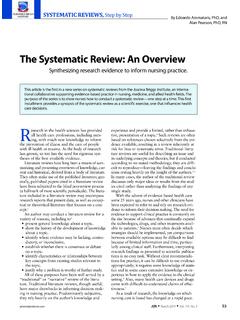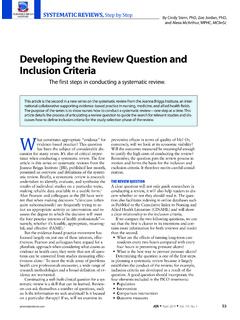Transcription of Urine Dipstick Testing: Everything You Need to Know
1 14 EMERGEnCy MEDICInE nEWS | MAy 2015 INFOCUSBY JAMES R. ROBERTS, MDThink of all the times you order urinalysis each shift. It seems to be a straightforward test, and most physicians think they are well versed in the interpretation of the results: you give it a glance and make a decision. The Dipstick analysis, the microscopic exam, and other information gleaned from a UA make their way into decision-making for a variety of diagnostic, therapeutic, and dis-position issues. Like most things learned in detail many years ago, the interpretation of the UA should be revisited on a regular find myself thinking I know Everything about a certain test only to find that the guidelines have changed, technology has ad-vanced, and previously held dogma is now relegated to the status of misconception. When one con-siders the complexity of the UA, it is obvious that this is not a simple test.
2 The intricacies and subtleties are actually quite amazing. This month s column focuses on dip-stick testing , and next month s will review Urine : A Comprehensive ReviewSimerville J, Maxted WC, Pahira JJAm Fam Physician2006;74(7):1096 The authors of this nifty review dis-cuss the value of the standard UA for diagnosing many urinary tract conditions, including malignancy and metabolic issues. The review covers the correct method for per-forming urinalysis and highlights the importance and diagnostic value of a number of abnormal res-ults found on the Dipstick and with microscopy. Information gained for the UA is termed invaluable by these urologists from Georgetown Collection: A mid-stream clean-catch technique is usually adequate for most men and women and in most ED situations. These authors say (and many would disagree) that the time-honored ritual of cleaning the ex-ternal genitalia in women has little or no proven benefit, although it is commonly emphasized.
3 Some re-views put the contamination rates as similar in specimens obtained with or without prior cleaning. (Arch Intern Med 2000;160[16]: 2537.) Urine should be refrigerated if it cannot be examined for more than two hours because delayed analysis can produce unreliable Properties: A variety of foods, medications, metabolic products, and infections can cause abnormal Urine colors and odors. normal Urine is clear and light yel-low in color. Concentrated Urine produces a darker color, a common finding in the morning after overnight water restriction. Cloudy Urine can be normal, usually caused by precipitated phosphate crystals in alkaline Urine . Significant pyuria also can cause clouded clarity is a good but not infallible guide to the presence or absence of UTI. (Pediatrics 2000; 106[5]:E60.) Many believe that odoriferous Urine is a sign of infec-tion, but it can simply represent a concentrated specimen or a partic-ular diet.
4 Urine that has prolonged bladder retention time can develop an ammonia-like odor. A fecal smell in the Urine suggests a GI-bladder fistula. Certain foods such as as-paragus or beets and a variety of medications can change the odor or color of Urine . Myoglobin colors the Urine brown, carrots can pro-duce a deep yellow color, and pseudomonas infections, propofol, and amitriptyline may give a blue/green hue to the Analysis: The accuracy of detecting microscopic hematuria, significant proteinuria, or urinary tract infection is a subject of much interest and practicality to emer-gency physicians. The Urine Dipstick has false-positive and false-negative results, and a list is presented in the table. It also should be noted that the commonly used Urine Dipstick has a finite lifespan, should be kept in a closed container, and should not be constantly exposed to air. testing with outdated and improp-erly stored materials can lead to er-roneous results.
5 Dipstick testing is quite helpful, serving as a screening test for some conditions and a definitive test for others. Dipstick testing in complicated cases or seri-ous disease must be correlated with microscopy and clinical Specific Gravity: Urine specific gravity (USG) generally correlates with the Urine osmolality. The most useful information de-rived from the USG is insight into the patient s hydration status and the concentrating ability of kidneys. The latter function is disrupted in a variety of normal USG ranges from to USG less than is suggestive of relative hydration, and values greater than in-dicate relative dehydration. Patho-logic conditions that increase the USG without regard to hydration included glycosuria and syndrome of inappropriate antidiuretic hormone secretion (SIADH). Osmolality is the more important parameter to measure in such cases. A decreased USG, also known as dilute Urine , is associated with diuretic use, diabetes insip-idus, adrenal insufficiency, aldoster-onism, or a plethora of conditions causing impaired renal should be noted that the purpose of the kidney is to concen-trate Urine when needed.
6 Many renal diseases alter this concentrat-ing function and result in a fixed specific gravity about , the specific gravity of the glomerular filtrate. This is known as isosthen-uria, a condition seen, for example, in patients with renal dysfunction because of sickle cell pH: The Urine pH gener-ally reflects the serum pH, but the primary and normal function of the kidney is to acidify the Urine . nor-mal serum pH is , but the normal urinary pH ranges from to 8. Because of normal metabolic activ-ity, the generally accepted normal pH of Urine is about to The kidney cannot acidify the Urine in renal tubular acidosis (RTA), so the Urine can be alkaline while the patient s serum demonstrates a metabolic Urine pH can be related to diet. Acid Urine can be the result of ingesting fruits (hence the use of cranberry juice) that acidify the Urine . Diets high in citrate and in citrus fruits, legumes, and veget-ables can cause alkaline Urine .
7 Meat eaters tend to have more acidic Urine , and vegetarians tend to have alkaline Urine . Alkaline Urine in the presence of a documented UTI may suggest infection with a ur-ea-splitting organism (such as pro-teus). Triple phosphate crystals (magnesium ammonium phosphate crystals) in alkaline Urine can form Clear Urine with a Dipstick strongly positive for blood usually means myoglobinuria. In such cases, the microscopic analysis would be negative for RBCs. Significant myoglobinuria can produce acute renal Dipstick testing : Everything You Need to KnowJames R. Roberts, MDLWW-EMN_May 1415/04/15 10:31 PM EMERGEnCy MEDICInE nEWS | MAy 2015 15 INFOCUSa staghorn calculus. Uric acid stones form in an acidic : The strict definition of hematuria by the American Uro-logical Association is the presence of three or more red cells per high-powered field in two of three Urine samples.
8 The Urine Dipstick is used to test for the peroxidase activity of erythrocytes, not for the actual presence of the physical RBC. Of course, myoglobin and hemoglobin produce a positive Dipstick for hematuria because these sub-stances also will catalyze this reac-tion; these are the end-products of hemolyzed RBCs or muscle break-down. High doses of vitamin C will inhibit this process, and can inval-idate the Dipstick for this test. This also holds true for stool guaiac testing ; vitamin C can produce a false-negative occult blood in stool. It has always been standard that a positive Dipstick for blood in the absence of RBCs by micro-scopy is indicative of myoglobin-uria or hemoglobinuria, not true authors present a table list-ing 45 causes of hematuria; some rare ones, such as Fabry s disease, will likely escape the detection and knowledge of the emergency phys-ician, but it is important to know that hematuria can be associated with malignant hypertension, numerous urinary tract cancers, infections, nephrolithiasis, nephritis (lupus) and vasculitis, tubercu-losis, and a variety of drugs, in-cluding the obvious heparin and casts are classic for acute glomerulonephritis.
9 Hematuria also can be associated with TTP, renal vein thrombosis, sickle cell trait, or merely running a marathon. Contrary to popular belief, significant hem-aturia will not elevate the protein concentration to the required cutoff deemed positive, 3 plus or more on the Dipstick . The authors note that up to 20 percent of pa-tients with a gross hematuria have a urinary tract malignancy, so this condition requires a full workup. Hematuria, in the absence of pro-teinuria or RBC casts, suggests a pure urologic cause (stones/ malignancy) for : Healthy kidneys limit the protein permeability of the glomerular capillaries, but dis-eased kidneys allow more protein to be filtered so proteinuria is a hallmark of a variety of renal dis-eases. Blood proteins are normally filtered and then reabsorbed by the proximal tubule cells. Urinary proteins include primarily albumin, but some serum globulins are de-tected.
10 The actual definition of pro-teinuria is the excretion of more than 150 mg of protein per day. Patients with early renal disease may have microalbuminuria. Early diabetic nephropathy may not be detected by Dipstick testing , so it is not a good screening test for this condition. The Dipstick test is sensitive almost entirely to albumin; it will not detect low concentrations of globulins or the Bence-Jones proteins associated with multiple Dipstick is actually quite sensitive for proteinuria, and pro-duces false-positive results by reacting to minor proteinuria that would not be considered clinically significant. Concentrated early morning Urine may give the false impression of significant proteinuria. The authors state that the Dipstick must be 3 plus or greater for pro-tein to be considered significant. Interestingly, prolonged standing can produce proteinuria, termed orthostatic (postural) proteinuria.






